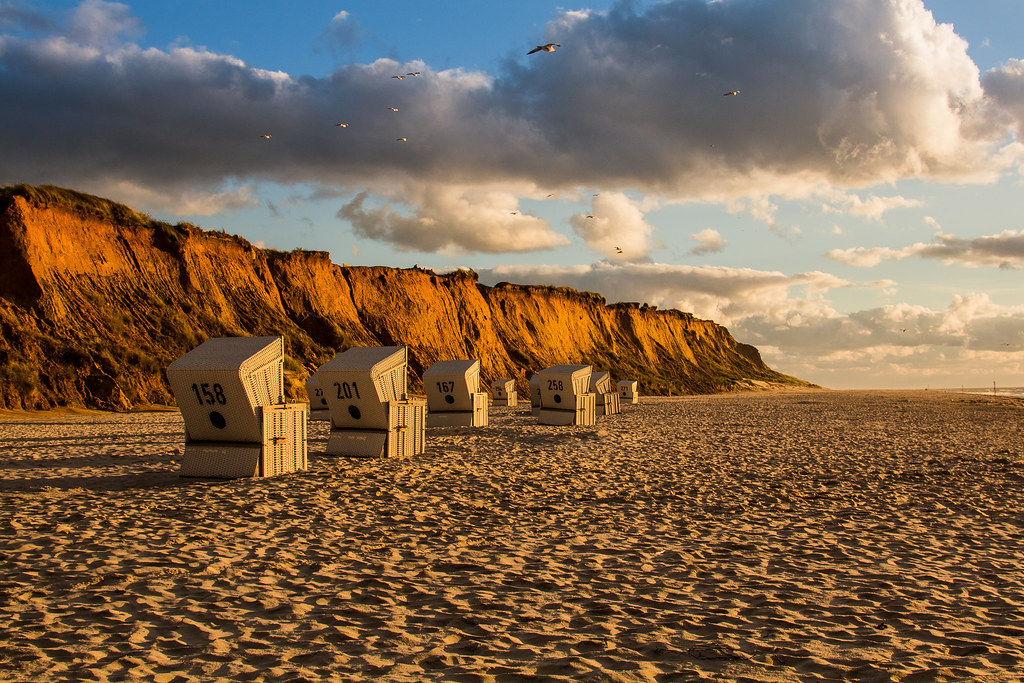Siegward Sprotte must have been one of Emil Orliks (1870-1932) last students in Berlin. Spanning a period of 25 years of teaching in Berlin among his first students had been many older women artists trained and educated in the classic tradition followed by a next generation of Art-Nouveau and Jugenstil artists. His last students will have been heavily influenced by expressionism.
I am acquainted with Sprotte because of one (1956) woodcut showing the iconic "Rotes Klif" (red cliff) on the German North-Sea island of Sylt. It lead me to his colorful watercolor drawings ("scribbles") of beach, dunes and North Sea.
Sprotte must have been familiar with the artistic world of Fritz Zalisz who visited Sylt in the 1920's although I could not discover how they were acquainted. Maybe a passing reader will tell me in due time. Both artists have tried at woodblock printmaking but only a few examples are known to me. Both artist need only a minimum of lines to share with us what they saw and what they felt. I include their biographies, composed from several sources, below.
All pictures embiggen by left mouse-click.
All pictures borrowed freely from the Internet for friendly, educational and non commercial use only
Biographies:
Sprotte, Siegward
(Postdam
20-04-1913 – 07-09-2004 Kampen/Sylt)
Painter, art philosopher and printmaker.
Started his artistic studies with Adolf
Dahle (1890-1954) and studied from 1931-1937 in Berlin at the “Vereinigten Staatsschulen für freie und angewandte
Kunst” with Emil Orlik
(1870-1932), Kurt Wehlte (1887-1973)
and Maximillian Klewer (1891-1963) He claimed to have been a masters student of
Karl Hagemeister (1848-1933) from
1930 until his death in 1933. Although there is no written evidence his
influence seems evident.
His work was admired and much praised during
the National Socialist period, exhibiting in the 1939, 1941, 1942 and 1944 “Großen Deutschen Kunstausstellung” with
10 works.
He developed a life long friendship with Karl Foester (1874-1970) a gardener,
perennial breeder and garden philosopher who lived in Potsdam-Bornim since
1911. Sprotte lived from 1945 in Potsdam-Bornim and during summer in the
village of Kampen on the North-Sea island of Sylt. Here in his studio and
exhibition rooms many paintings of the island were created. He developed in the
1950’s a “simplified” expressionist style with sparse use of line using
watercolour much like Fritz Salisz
(1893-1971) who stayed in Sylt in 1922/23. He was acquainted with and influenced by artists Erich Heckel (1883-1970) Karl Schmidt-Rottluff (1884-1976), Hans Purrmann (1880-1966) and Emil Nolde (1867-1956).
Zalisz,
Fritz
(Gera 17-10-1893
– 13-12-1970 Leipzig)
Painter, sculptor, poet, graphic artist and
printmakler. Son of a Goldsmith and juweler. Studied first zoology with
zoologist, philosopher and Charles Darwin follower Ernst Heackel (1834-1919) in Jena co-operating with him and who
introduced him to study with Gabriel von
Max (1840-1915) and sculptor Adolf
von Hillebrandt (1847-1921) in Munich. In Munich he met Vladimir Lenin (1870-1924) who’s
portrait he drew. In WWI he participated as a war-artist (in the 58th
devision) continuing his studies at Leipzig ”Akademie
für Grafik und Buchgewerbe” with Otto
Richard Bossert (1874-1919), Alois
Kolb (1875-1942) and Adolf Lehnert
(1862-1948). Studied also in Berlin, worked in Leipzig and travelled to
Holland, Belgium, France and Switzerland.
He mainly worked as graphic artist, creating a series of 24 lithographies for “Faust”, 12 for “Iphegenie”
and 12 for “Christus”. He made
monumental ornamentions for buildings in Leipzig and Altenhain that mostly were
destroyed in WWII.
In 1927/28 he was offered a professorship
in the University of Madrid which he declined. In the early 1920’s he stayed
regularly on the North-Sea island of Sylt were he created many drawings in
watercolour and chalk, etchings and sketches. In 1940 he moved to
Leipzig-Holzhausen and after WWII he created mainly small and animal
sculptures.
Three of his works were exhibited in the
(1996) Oskar Kokoschka (1886-1980)
exhibition in Dresden. Exhibited 1923 in the Chemnitz “Kunsthutte” and “Kunsthalle Dessau” and in 1928 in Madrid.
-----------















The oil looks likwe Nolde in the small image but once you look at the larger image it's really more like the landscapes the British artist Frank Auerbach made showing Primrose Hill in London. The colour sketches are a lot like the most rasdical of Turner's watercolours. He obviously had a wide range and didn't stand still even if he lived on one small island. Interesting post.
ReplyDeleteThank you for introducing Auerbach to me. He is very interesting and I like his Primrose Hill landscapes. There's definitely only one Turner, his watercolor sketches are a landmark and changed the world of Art. Quite a few artists visited Sylt, but Sprotte came to stay. I like (and recognize) that !
ReplyDelete